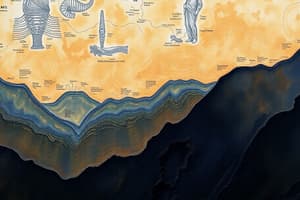Podcast
Questions and Answers
What are fossil-forms?
What are fossil-forms?
Fossil-forms are forms that occur in the rocks.
What can the fossil record be used to delineate?
What can the fossil record be used to delineate?
Ages, epochs, periods and other intervals
Which of the following is a method of dating fossils?
Which of the following is a method of dating fossils?
- Radiometric Dating
- Thermal Ionization Mass Spectrometer
- Relative Dating
- All of the above (correct)
Describe original horizontality.
Describe original horizontality.
Describe Superposition.
Describe Superposition.
Describe cross-cutting inclusion.
Describe cross-cutting inclusion.
What are the most common Precambrian fossils?
What are the most common Precambrian fossils?
Match the era with its corresponding description.
Match the era with its corresponding description.
Approximately when did abundant microscopic life begin?
Approximately when did abundant microscopic life begin?
The Earth was very rich in free oxygen early in it's history.
The Earth was very rich in free oxygen early in it's history.
What is an example of blue-green algae from the Midprecambrian period?
What is an example of blue-green algae from the Midprecambrian period?
Approximately when did the age of reptiles begin?
Approximately when did the age of reptiles begin?
What characterizes the end of the Cambrian period?
What characterizes the end of the Cambrian period?
Give an example of a fossil from the Cambrian period.
Give an example of a fossil from the Cambrian period.
What characterizes the ordovician period?
What characterizes the ordovician period?
What kind of animals were common during the time of Lichens?
What kind of animals were common during the time of Lichens?
Which animals are insignificant during the Triassic period?
Which animals are insignificant during the Triassic period?
What period was a warm tropical greenhouse?
What period was a warm tropical greenhouse?
The Paleocene period is part of which larger period?
The Paleocene period is part of which larger period?
Flashcards
Fossils
Fossils
Forms that occur in rocks, used to delineate ages, epochs, and periods.
Original Horizontality
Original Horizontality
Strata are deposited from above
Superposition
Superposition
Older rocks are below younger rocks.
Cross-Cutting inclusion
Cross-Cutting inclusion
Signup and view all the flashcards
Paleozoic
Paleozoic
Signup and view all the flashcards
Mesozoic
Mesozoic
Signup and view all the flashcards
Cenozoic
Cenozoic
Signup and view all the flashcards
Mesozoic Era
Mesozoic Era
Signup and view all the flashcards
Triassic Period
Triassic Period
Signup and view all the flashcards
Jurassic Period
Jurassic Period
Signup and view all the flashcards
Study Notes
- Fossil forms occur in rocks.
- Fossil records delineate ages, epochs, and periods.
- Radiometric dating includes thermal ionization mass spectrometry.
- Relative dating is also used.
Principles of Stratigraphy
- Original horizontality: Strata are deposited from above.
- Superposition: Older strata are below younger strata.
- Cross-cutting inclusion: Dike cuts across older rocks.
Precambrian Fossils
- The most common fossils are stromatolites.
- 4.6 billion years ago, there was abundant microscopic life.
- Gases were brought to the surface by volcanic activity.
- Conditions were slowly cooled.
- The atmosphere was very poor in free oxygen.
- Mid-Precambrian: Blue-green algae.
Paleozoic, Mesozoic, and Cenozoic Eras
- Paleozoic: Ancient life.
- Mesozoic: Middle life.
- Cenozoic: Recent life.
- Began about 544 million years ago.
- 300 million years ago.
- Sea levels rose.
- This is divided into six periods.
Cambrian Period
- Calcium carbonate and calcium phosphate were present.
- The Earth was generally cold.
- The period began with an extinction event.
- Example: Elivaia kingli.
Ordovician Period
- There was a rich variety of marine life.
- The first primitive plants began to appear.
- This occurred before the 2nd extinction.
- Example: Lichens.
- Air-breathing scorpions and millipedes were common.
- Fish started becoming more widespread.
Mesozoic Era- Age of Reptiles
- Divided into three periods.
Triassic Period
- The supercontinent of Pangea began to pull apart.
- New kinds of animals evolved after the great extinction at the end of the Permian.
- Rise of dinosaurs.
- Spread of true pines and redwoods.
- Mammals were insignificant.
Jurassic Period
- Warm, tropical greenhouse climate.
- Giant, plant-eating dinosaurs roamed the earth.
- Smaller but vicious flying reptiles and the first birds appeared.
- Mammals replaced reptiles.
- Angiosperms replaced gymnosperms.
Cenozoic Era
- Age of mammals and the flowering plants.
- Made up of two periods.
Tertiary Period, Paleocene Epoch
- Sea fell to expose dry land on much.
- The climate was much warmer and more uniform.
- Evolution proceeded rapidly.
Studying That Suits You
Use AI to generate personalized quizzes and flashcards to suit your learning preferences.



